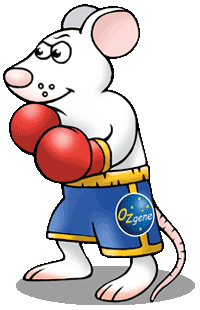Impaired mRNA processing in Dido knockout mice
Impaired mRNA processing in Dido knockout mice
Studying gene function
Researchers are able to use knockout mice to study the effect of a specific gene on an organism. By removing (or ‘knocking out’) a target gene in the mouse genome, researchers can observe the mouse phenotype and how the mouse model develops without the gene over time. Knockout mouse models have helped researchers understand the function of many genes, including those involved in various human diseases such as cancer, diabetes and heart disease.
Stem Cells and Immunity group at CNB, Spain
Gene knockouts are utilised by the Stem Cells and Immunity group at the National Centre for Biotechnology (CNB) in Madrid, Spain, led by Dr Carlos Martínez Alonso. The group studies embryonic stem (ES) cell differentiation and chromosome instability, focusing on the Dido locus – a gene complex strongly expressed in ES cells. The Dido locus encodes for three splice variants (Dido1, Dido2 and Dido3) and Martinez Alonso’s group have identified Dido1 as a gene involved in ES cell differentiation. The largest protein encoded by the Dido1 gene is DIDO3 which is required for accurate mRNA splicing and correct transcription termination.
Dido mouse knockout phenotype
The Martínez Alonso group utilised a Dido1 conditional knockout mouse model generated by Ozgene to study the effect of Dido1 gene inactivation in mice. In a paper published in Cell Death & Disease in 2021, the group found that the deletion of exon 16 of the Dido1 gene encoding for the DIDO3 protein leads to embryonic lethality. The ES cells failed to differentiate and analysis of the RNA sequence showed aberrations in splice isoforms and RNA termination of mature mRNAs.
In their recent paper published in Cell & Bioscience in 2022, Drs Julio Gutiérrez, Karel H. M. van Wely and Carlos Martínez Alonso from CNB used the Cre-LoxP functionality of the Dido1 mouse model to study the effects of Dido1 gene inactivation at different stages in adult mice. They found that the Dido1/DIDO3-deficient mice survived the gene deletion, but the knocked out gene in adult mice led to mild hepatitis, testicular degeneration and progressive ataxia. This phenotype is related to systemic changes in splicing and transcriptional readthrough in the mRNA population, which had been studied in fibroblasts previously derived from the Ozgene model.
These results derived from the Dido1 knockout phenotype highlight the significance of the mRNA processing machinery. These insights can aid in the understanding of human mRNA metabolism and its importance to human health.
Mouse models & more information
For more information on the Dido1/DIDO3 research, read the publications below and visit the Stem Cells and Immunity group page. Also visit Ozgene’s mouse model page for more information on our services.

Cell Biosci. 2022 Jun 7;12(1):84. doi: 10.1186/s13578-022-00804-8.
Hepatitis, testicular degeneration, and ataxia in DIDO3-deficient mice with altered mRNA processing
Julio Gutiérrez, Karel H M van Wely, Carlos Martínez-A
Cell Death Dis. 2021 Jun 21;12(7):637. doi: 10.1038/s41419-021-03906-2.
Impaired stem cell differentiation and somatic cell reprogramming in DIDO3 mutants with altered RNA processing and increased R-loop levels
Agnes Fütterer, Amaia Talavera-Gutiérrez, Tirso Pons, Jesús de Celis, Julio Gutiérrez, Verónica Domínguez Plaza, Carlos Martínez-A
Nucleic Acids Res. 2019 Jun 4;47(10):5381-5394. doi: 10.1093/nar/gkz235
Dido3-dependent SFPQ recruitment maintains efficiency in mammalian alternative splicing
Carmen Mora Gallardo, Ainhoa Sánchez de Diego, Julio Gutiérrez Hernández, Amaia Talavera-Gutiérrez, Thierry Fischer, Carlos Martínez-A, Karel H M van Wely
Further research articles related to mRNA processing and transcriptome featuring Ozgene mouse models
Elife. 2019 Jan 24;8. pii: e39304. doi: 10.7554/eLife.39304.
An ancient germ cell-specific RNA-binding protein protects the germline from cryptic splice site poisoning
I Ehrmann;JH Crichton;MR Gazzara;K James;Y Liu;SN Grellscheid;T Curk;D de Rooij;JS Steyn;S Cockell;IR Adams;Y Barash;DJ Elliott
Cell Mol Gastroenterol Hepatol. 2019 Mar 2;7(4):819-839. doi: 10.1016/j.jcmgh.2019.01.009.
Mouse Model of Mutated in Colorectal Cancer Gene Deletion Reveals Novel Pathways in Inflammation and Cancer
N Currey;Z Jahan;CE Caldon;PN Tran;F Benthani;P De Lacavalerie;DL Roden;BS Gloss;C Campos;EG Bean;A Bullman;S Reibe-Pal;ME Dinger;MA Febbraio;SJ Clarke;JE Dahlstrom;MRJ Kohonen-Corish
Am J Hematol. 2021 Jun 1;96(6):698-707. doi: 10.1002/ajh.26171. Epub 2021 May 3.
Hematopoietic expression of a chimeric murine-human CALR oncoprotein allows the assessment of anti-CALR antibody immunotherapies in vivo
Sarada Achyutuni, Harini Nivarthi, Andrea Majoros, Eva Hug, Christina Schueller, Ruochen Jia, Cecilia Varga, Michael Schuster, Martin Senekowitsch, Dimitris Tsiantoulas, Anoop Kavirayani, Christoph J Binder, Christoph Bock, Oleh Zagrijtschuk, Robert Kralovics
Endocrinology. 2021 Aug 26;bqab179. doi: 10.1210/endocr/bqab179.
Cochlear fibrocyte and osteoblast lineages expressing type 2 deiodinase identified with a Dio2 CreERt2 allele
Lily Ng, Ye Liu, Hong Liu, Douglas Forrest
Mol Ther. 2021 Nov 29;S1525-0016(21)00635-3. doi: 10.1016/j.ymthe.2021.11.018.
The long non-coding RNA NRON promotes the development of cardiac hypertrophy in the murine heart
Jeannine Hoepfner, Julia Leonardy, Dongchao Lu, Kevin Schmidt, Hannah J Hunkler, Sinje Biß, Ariana Foinquinos, Ke Xiao, Kumarswamy Regalla, Deepak Ramanujam, Stefan Engelhardt, Christian Bär, Thomas Thum

